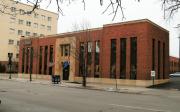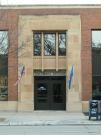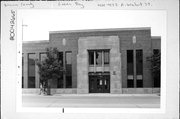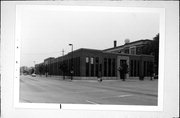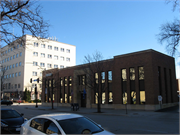Property Record
400-422 E WALNUT ST
Architecture and History Inventory
| Historic Name: | Columbus Building |
|---|---|
| Other Name: | Columbus Office Building |
| Contributing: | Yes |
| Reference Number: | 42665 |
| Location (Address): | 400-422 E WALNUT ST |
|---|---|
| County: | Brown |
| City: | Green Bay |
| Township/Village: | |
| Unincorporated Community: | |
| Town: | |
| Range: | |
| Direction: | |
| Section: | |
| Quarter Section: | |
| Quarter/Quarter Section: |
| Year Built: | 1936 |
|---|---|
| Additions: | |
| Survey Date: | 19862017 |
| Historic Use: | large office building |
| Architectural Style: | Art Deco |
| Structural System: | Steel Frame |
| Wall Material: | Brick |
| Architect: | Harry Williams |
| Other Buildings On Site: | |
| Demolished?: | No |
| Demolished Date: |
| National/State Register Listing Name: | Green Bay Downtown Historic District |
|---|---|
| National Register Listing Date: | 5/13/2019 |
| State Register Listing Date: | 2/16/2018 |
| National Register Multiple Property Name: |
| Additional Information: | Excellent Art Deco design. Building is essentially a classic plan having a main block with end pavillions linked by long hyphens of unequal length. The main block and the end pavillions project only slightly from the hyphens on the main facade while the right-hand, or westerly pavillion is elongated along the Adams Street facade and contains a separate side entrance and is itself terminated by a third pavillion, creating a second symmetrical facade. The building rests on a tall foundation sided in buff cut stone sheets which rise to the level of the first floor window sills. The central block facing on Walnut Street contains the main entrance doors and has triple window openings above which projects outward over the doors. Both are framed by a massive buff cut stone surround whose sides and uppermost portion are stepped back from the main mass of the surround. The same treatment is used for the Adams Street entrance, although on a somewhat smaller scale. The wide freize band above the windows has a small octagonal cut stone plaque abbve the pier which separates every group of three windows. The parapet above is surmounted by a cut stone coping. All windows in the building have been modernized with 1 lite windows and the interior has been totally remodeled. Otherwise, this excellent sober design is largely original. 2017-NRHP District Nomination This excellent Art Deco style building sits at the southeast corner of E. Walnut and S. Jefferson streets. Both street-facing façades are individually symmetrical, with a central entrance connected to end pavilions by equal-length hyphens. The building rests on a tall foundation clad in cut stone sheets. This stone foundation includes the stone sills for the first-floor windows. This stone encircles the building, interrupted only at the entrances where the stone is used as a large entrance surround. The main façade faces Walnut Street. A central bay, which is taller than the rest of the building, houses the entrance and paired window openings to either side. There are three windows above the door, separated from one another by Deco style stone mullions that terminate in the stone surround above and just above the “COLUMBUS OFFICES” sign above the door. Stone with a vertical ribbed detail occupies the space below these window sills and above the sign. The windows and ribbed stone overhang the door slightly. The entire entrance surround is executed in cut stone sheets, stepped to be slightly narrower in the top third. The outer edges of the surround step back in relief towards the brick façade. A pair of first and second story windows are to either side of the entry surround. Each first and second story window, both here and elsewhere across the building, shares a recess in the façade, separated vertically by a dark panel. An elongated octagonal stone panel with carved, abstract, feather-like detail is centered above and between these windows. A two-story wing extends from the entrance pavilion to end pavilions. First and second story windows, slightly wider than those at the sides of the entrance, break up the brick façade. These windows are separated horizontally by vertical brick piers flush with and integral to the façade. Wider vertical piers of brick separate the windows into four bays, each bay with three windows at each floor. Octagonal stone panels with carved fountains are placed in the brick wall above each of the wider brick piers. A pavilion with six windows in each floor is located at the outer ends of the wings. These pavilions are slightly taller than the wings, and project slightly from the wings. The brick parapet along the entire façade is topped with a cut stone coping. The S. Jefferson Street façade is the side entrance to the west-end pavilion. Here, the central entrance is nearly identical to that on E. Walnut Street, but built to a slightly smaller scale. There are three windows at each floor to either side of the entrance surround. Taller side pavilions project slightly from the central portion of this façade. Each side pavilion here has three windows at each floor. This building, designed by Green Bay architect Harry Williams, was built as offices and remains in that use today. Early tenants included the Knights of Columbus and the Norbertine Fathers. All of the windows have been replaced with modern, energy-efficient types, but otherwise the exterior of the building has not changed. |
|---|---|
| Bibliographic References: | A. Sanborn maps B. Brown County tax rolls C. Harry Williams obituary, Green Bay News Chronicle, April 23, 1984 D. Timothy Heggland et al., Green Bay Intensive Survey Final Report (Green Bay: Redevelopment Authority, 1988), 192. |
| Wisconsin Architecture and History Inventory, State Historic Preservation Office, Wisconsin Historical Society, Madison, Wisconsin |

